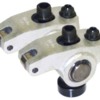Hi
I have problem with my new 383. The push rods goes bananas at 5500 rpm.
I have bought new complete AFD heads from AusFordParts and I can't find info about the valve springs that came with them.
My guess is valve float because of soft springs. Any other Ideas to look into?
The issue occur on diffrent cylinders and on intake and exhaust. The engine have 50 hours on it below 5500rpm without problem.
I have checked the heads for damages after the incident and they looks fine, puh...
I'll plan to test the springs for pressure rating this weekend.
Again, anything else I can look at that can cause this when reaching 5500rpm?
/Honken
Original Post


